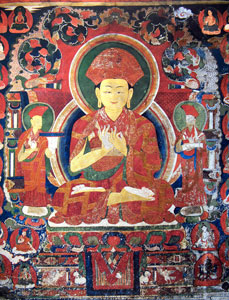

When Kyobpa Jigten Sumgon was 70 years old, he sent practitioners to three particularly sacred places, in three phases: to Mount Kailash (gangs ri), whose form corresponds to the body of Chakrasamvara, to Mount Lapchi (la phyi) in the present-day border area between Tibet and Nepal, the site of the speech of Chakrasamvara, and to Mount Tsari (tsa ri), the site of the mind of Chakrasamvara. The first group of ripa (ri pa), which are hermits practicing meditation in the mountains, sent by Jigten Sumgon to meditate in the caves of Mount Kailash was led by Nangphupa (nang phu pa, d. 1206), the second by Ngo Chenpo (gngos chen po) and Garpa Jangdor (gar pa byang rdor) in the beginning of the 13th century. In 1215 Jigten Sumgon sent out the third, largest and most important expedition to Kailash. It was led by Ghuya Gangpa (ghu ya sgang pa, also known as Ngo Choje Phuntsog Gyatso, dngos chos rje phun tshogs rgya mtsho). It was Ghuya Gangpa who laid the foundation of the Drikungpa in the Kailash area by establishing a monastery in a valley to the south of Mount Kailash.
The region of Western Tibet was under the rule of the kings of Guge (or Shangshung, zhang zhung) and Purang (pu rang). The Drikung Dorzins imparted teachings and empowerments not only to the rulers of the kings of Guge and Purang, but also to the kings of Mangyul (Ladakh) and the Khas Malla kingdom in Western Nepal, thus extending their influence over a large area. In return the rulers supported the Drikungpa and presented them with large territories meant for providing the income of their monasteries. The spiritual activities of the Drikungpa and their close contact with the local rulers led to the firm establishment of the sect in the three provinces of Ngari in Western Tibet (mnga ris skor gsum). A peak of the influence of the order was reached under the Dorzin Darma Gyaltsen (dar ma rgyal mtshan), who lived at Gyangdrag Monastery during the reign of the 5th Drikung throne holder Chung Dorje Drakpa (1210-1278). At that time besides Gyangdrag several well-known shrines belonged to the Drikungpa, like Nyanri (nyan ri), Dzutrul (rdzu ‘phrul), Riwotsegye (rib o rtse brgyad), Khojarnath and many other places in Purang, Trocho (gro shod) and Kunawar.

With the decline of the spiritual life and scholarship at Drikung during much of the 15th century the monasteries of the order in Western Tibet experienced a time of weakening. Almost no new monks made their way to the far away holy places and the few remaining monks were no more able to sustain the monasteries and hermitages. Some of them were provisionally lent to the Drukpa Kagyu, and eventually remained in the hands of the Drukpa order.
During the time of the 16th lineage holder Gyalwang Kunga Rinchen (1475-1527), who restored monastic discipline and improved the quality of study in Drikung, the monasteries in Ngari also experienced a period of renaissance. He had dispatched 300 ripa to mount Kailash. Not long thereafter, during the reign of the 17th lineage holder Gyalwang Rinchen Phuntsog (1509-1534), an outstanding personality was installed as Dorzin at Gyangdrag, Denma Kunga Drakpa (ldan ma kun dga’ grags pa). He was instrumental for the spread of the Drikung order to Mangyul – the region of what today is called Ladakh.

